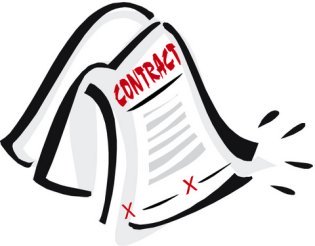A Non-Recourse Factoring Agreement Sample: Explained
 If you’re looking to sell your invoices as a way of raising capital, it’s important to understand the differences between recourse and non-recourse deals. Essentially, recourse factoring means you (or your business) is on the hook if your customers don’t pay the invoices you sold to the factoring company, and non-recourse factoring means you’re not on the hook. Think of non-recourse deals as “no strings attached” financing – the factoring company completely assumes the risk that the invoice won’t be paid by your customer.
If you’re looking to sell your invoices as a way of raising capital, it’s important to understand the differences between recourse and non-recourse deals. Essentially, recourse factoring means you (or your business) is on the hook if your customers don’t pay the invoices you sold to the factoring company, and non-recourse factoring means you’re not on the hook. Think of non-recourse deals as “no strings attached” financing – the factoring company completely assumes the risk that the invoice won’t be paid by your customer.
Obviously, there are many benefits to obtaining non-recourse accounts receivable financing. The credit/collection risk being assumed by the factoring company is the greatest benefit. So while you’re out looking for the best deal, be sure to reference this article. Despite the title, instead of providing you with a non-recourse factoring agreement sample, we thought we’d provide you with language that raises red flags – language that signals a deal is recourse. Since recourse deals have increased potential liability associated with them, it’s important you know how to identify the differences. But please don’t get us wrong here, recourse deals aren’t necessarily bad. Because the factoring company doesn’t assume as much risk, the fees are usually lower. But if you’re not willing to assume the risk of a recourse deal, you need to know how to identify one.
#1. Look for Specific Liability Language
When you read recourse language, you’ll know it. Typically a deal that doesn’t have recourse language is non-recourse, therefore you should look for recourse language. The factoring agreement (also known as a “Purchase & Sale Agreement”) will have something like this:
“Seller shall offer for sale to Purchaser as absolute owner, with recourse, Seller’s Accounts as listed periodically on the Seller’s accounts receivable schedule…”
Whereas a non-recourse deal will have language like this:
“Seller hereby agrees to sell and assign to Buyer, and Buyer hereby agrees to purchase from Seller, certain accounts arising from Seller’s ordinary course of business…”
Notice how there is zero language about “with recourse” in the second quotation. Also, for purposes of a factoring contract, “buyer” and “purchaser” mean the same thing. The word and specific language of each clause depend on the factoring company’s attorney.
#2. Look for a Skewed “Repurchase” Clause
Sometimes, not but always, factoring companies will include a “repurchase” clause in a factoring contract. These clauses govern a repurchase of the invoice by your company, from the factoring company. Because factoring involves the “purchase and sale” of invoices, where your business sells invoices to the factoring company, a repurchase means you buy them back. This could happen for any number of reasons, like the invoice being outstanding for more than 90 days. Again however, it’s important to understand the language.
Purchaser may require that Seller repurchase, on demand, or, at Purchaser’s option, by Purchaser’s charge to the Reserve Account: Any Purchased Account, the payment of which has been disputed by the Payor; Any Purchased Account owing from an Account Debtor or Payor which (a) in Purchaser’s reasonable credit judgment has become insolvent or (b) has indicated an inability or unwillingness to pay the Purchased Account when due; Any Purchased Account that remains unpaid beyond the Late Payment Date.
Notice that in the above clause, the factoring company (the Purchaser) can force you buy back the invoice (the “Purchased Account”) on demand – even if your client has become insolvent, refuses to pay, or pays late.
We can’t say it loud enough – that is NOT a non-recourse deal!
Insolvency by your customer, late payment and refusal to pay are exactly the types of risks assumed by the factoring company in a true non-recourse deal. Also note that in the above clause, the factoring company might not make you cough up the cash; rather, they will “charge” or debit your reserve account. Meaning, any money of yours the factoring company is holding in reserve, they will take for themselves. Effectively, you still have to pay them.
Now compare that with language from a non-recourse contract. See if you can note the difference(s):
Upon written notice to Purchaser at any time that any Approved Receivable remains unpaid for more than ninety (90) days, Seller may repurchase such Approved Receivable for an amount equal to the sum of…
The language here indicates that the option remains with the you, the original seller. With this language, the factoring company cannot simply “put” the receivable back to you if the invoice doesn’t get paid. The language of the clause is silent on instances where you would have to repay. Basically the risks discussed above – refusal to pay, late payment or insolvency of your clients – are being assumed by the factoring company.
#3. Summary and Tips
- Look for the recourse language and the repurchase language – that’s it. Arguably these are the two most important that distinguish non-recourse from recourse.
- The recourse language will almost always appear in the first or second clause of the contract.
- The repurchase clause, whether recourse or non-recourse, will almost always have a calculation of the repurchase amount associated with it. Read this carefully.
- IMPORTANT – Some contracts might not have recourse language in the very beginning, making it appear to be a non recourse deal. However, the repurchase clause might give the factoring company the ability to force you to repurchase the account if the invoice doesn’t pay.
This is a nifty way for factoring companies to “disguise” a recourse deal as non recourse.
And lastly, contact your attorney to thoroughly comb through any contract before signing away.
We hope you found this non recourse factoring agreement sample helpful. As always, don’t hesitate to reach out to us for assistance securing you, or reviewing, factoring deals on your behalf.
DISCLAIMER: this article is not intended as legal advice. This article is is merely an informative, hypothetical article with examples about recourse language versus a non recourse factoring agreement sample. We advise that before you sign any deal, you take this article with a grain of salt, reference your attorney, and make sure you understand the language even after your attorney has explained it to you.




 If you’ve done enough research, you’ve probably come by many articles that say “invoice factoring” and “invoice financing”. On the surface they may appear to be the same product but they’re quite different. However, before we get into the differences it should be noted that they do serve the same purpose. Both invoice factoring and invoice financing offer a “liquidity” source for businesses. Meaning, they can us their unpaid invoices as source of immediate cash.
If you’ve done enough research, you’ve probably come by many articles that say “invoice factoring” and “invoice financing”. On the surface they may appear to be the same product but they’re quite different. However, before we get into the differences it should be noted that they do serve the same purpose. Both invoice factoring and invoice financing offer a “liquidity” source for businesses. Meaning, they can us their unpaid invoices as source of immediate cash.